11.3 Anatomy of a Planet: Earth’s Internal Structure
Describe the planet’s internal structure and understand the importance of lithospheric plate movement.
Generations have been intrigued by the mystery of what lies beneath Earth’s surface. The nineteenth-
The modern scientific understanding of Earth’s interior does not include mortal sin or a frozen core. Instead, Earth’s interior is hot and under enormous pressure due to the weight of overlying rock. At Earth’s center, the pressure is some 3,600,000 times greater than that found on the surface.
The temperature of Earth’s interior increases with depth. This pattern is called the geothermal gradient. In deep gold mines in South Africa, temperatures reach almost 54°C (130°F) only 3.5 km (2 mi) below the surface. At 40 km (24 mi) below the surface, the temperature climbs to about 500°C (930°F). The temperature at the core of the planet is about 6,000°C (10,832°F)—nearly as hot as the Sun’s surface.
Four factors have created and continue to create a hot Earth interior:
Friction: As we have seen, Earth formed through the coalescence of dust and gas. The denser elements, such as iron and nickel, sank toward the middle of the planet beneath the less dense materials, such as silicon and magnesium. This sorting of materials by density resulted in movement that generated friction and, therefore, heat.
Asteroid bombardment: The Late Heavy Bombardment of early Earth by asteroids also generated heat from friction and kept Earth’s surface molten for several hundred million years.
Tidal forces: When the Moon first formed, it was only about 24,300 km (15,000 mi) away from Earth (compared with today’s average distance of 384,399 km, or 238,854 mi). Because it was so close, the Moon’s gravitational pull exerted enormous tidal forces, which distorted Earth’s shape and created heat from the friction of the movement.
Radioactivity: The fourth source of Earth’s internal heat is radioactive decay of unstable elements, mainly potassium, uranium, and thorium. These elements give off heat during the decay process.
How Do Scientists Know What Is Inside Earth?
The average density of Earth is about 5.5 g/cm3, a figure calculated by dividing the mass of the planet by its volume. The average density of the crust’s rocks, however, is less than this (about 2.92 g/cm3), indicating that Earth’s interior must be denser than its surface.
Most of what is known of Earth’s deep interior has come from analysis of the behavior of seismic waves: energy released by earthquakes that travels through Earth’s interior. An earthquake is a sudden shaking of the ground caused by movements of Earth’s crust. There are also other lines of direct and indirect evidence relating to Earth’s internal structure (Figure 11.9).
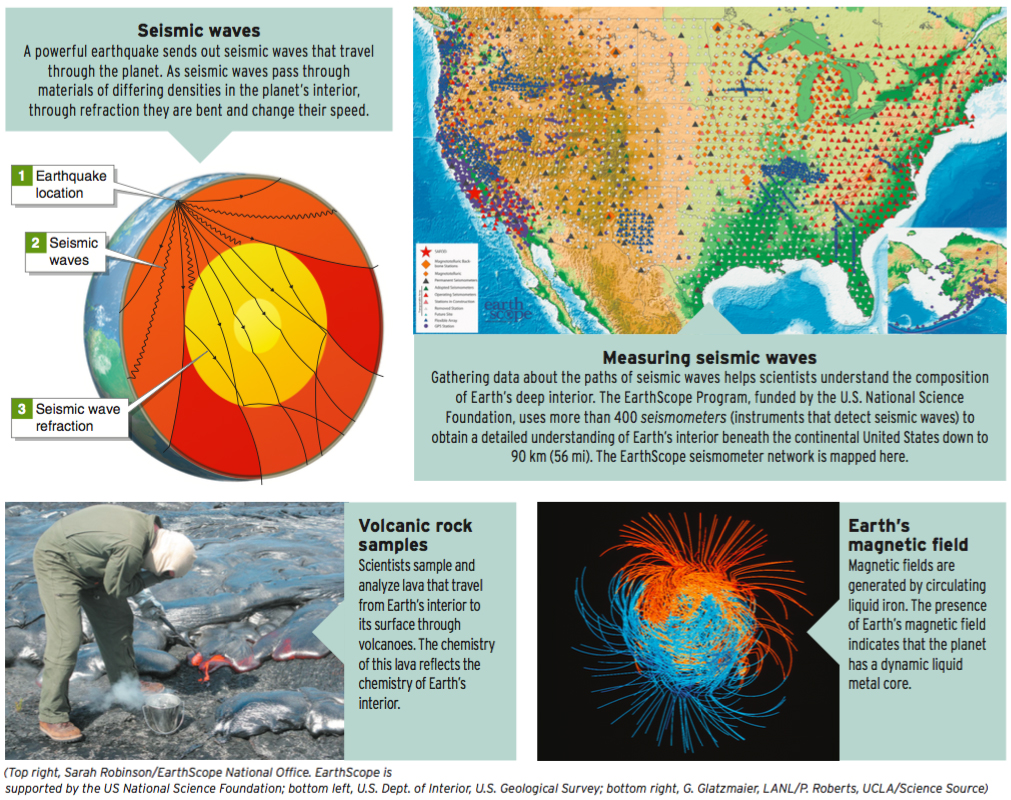
earthquake
A sudden shaking of the ground caused by movements of Earth’s crust.
seismic wave
Energy released by an earthquake that travels through Earth’s interior as a wave.
seismic waves
Energy released by an earthquake that travels through Earth’s interior as a wave.
Earth’s Interior Layers
It is no coincidence that Earth’s atmosphere, oceans, and interior are arranged in layers that decrease in density away from Earth’s center. In fact, the atmosphere and oceans are a continuum with the solid Earth. Each layer is made of matter in solid, liquid, or gaseous states. As Earth coalesced from dust and gas during the formation of the solar system, the densest materials settled deepest, leaving the least dense materials at the top. The same thing happens when a glass of unfiltered orange juice is left undisturbed for several hours: The heavy pulp settles to the bottom. Similarly, the atmosphere’s gas molecules are the least dense and lightest of Earth’s materials, and they therefore rest on top of the denser and heavier liquid oceans and the solid Earth.
Earth’s interior has three principal layers: the core, the mantle, and the lithosphere (Figure 11.10). Here, we will examine Earth’s interior layers, starting from the core and moving outward to the lithosphere.
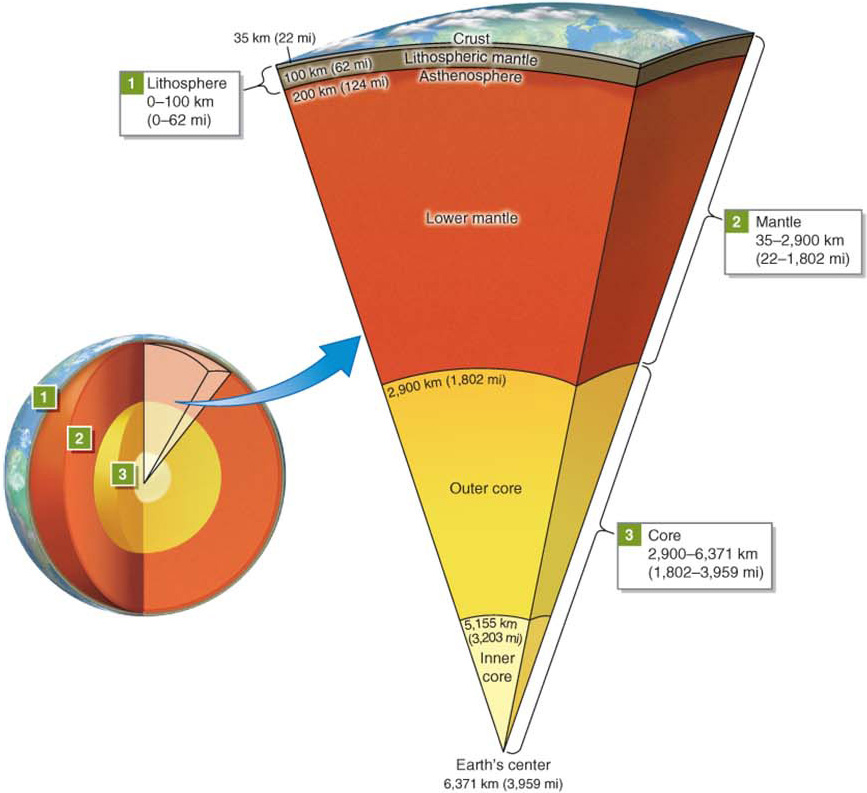
The Core
The center of Earth is 6,371 km (3,959 mi) below sea level. The solid inner core, which extends from Earth’s center to about 5,155 km (3,203 mi), is composed of a mixture of dense elements, mostly iron and nickel. Inner core temperatures reach up to 6,000°C (10,832°F). These temperatures would melt the inner core if not for the extreme high pressure found there that keeps the inner core solid.
inner core
The innermost layer of Earth, composed of solid iron and nickel.
The outer core, which surrounds the inner core, is composed of a liquid alloy of iron and nickel. Temperatures in the outer core are as low as 4,000°C (7,232°F) and increase toward the inner core. The outer core extends to about 2,900 km (1,802 mi) below the surface. The outer core is liquid because pressures within it are less than those of the inner core, allowing the outer core to melt and flow. This circulating liquid metal generates electrical currents and creates Earth’s magnetic field.
outer core
The second innermost layer of Earth, composed of a liquid alloy of iron and nickel, which generates Earth’s magnetic field.
A familiar use of Earth’s magnetic field is as a navigational aid for people and migratory animals. As Figure 11.11 illustrates, magnetic north and geographic north are not the same.
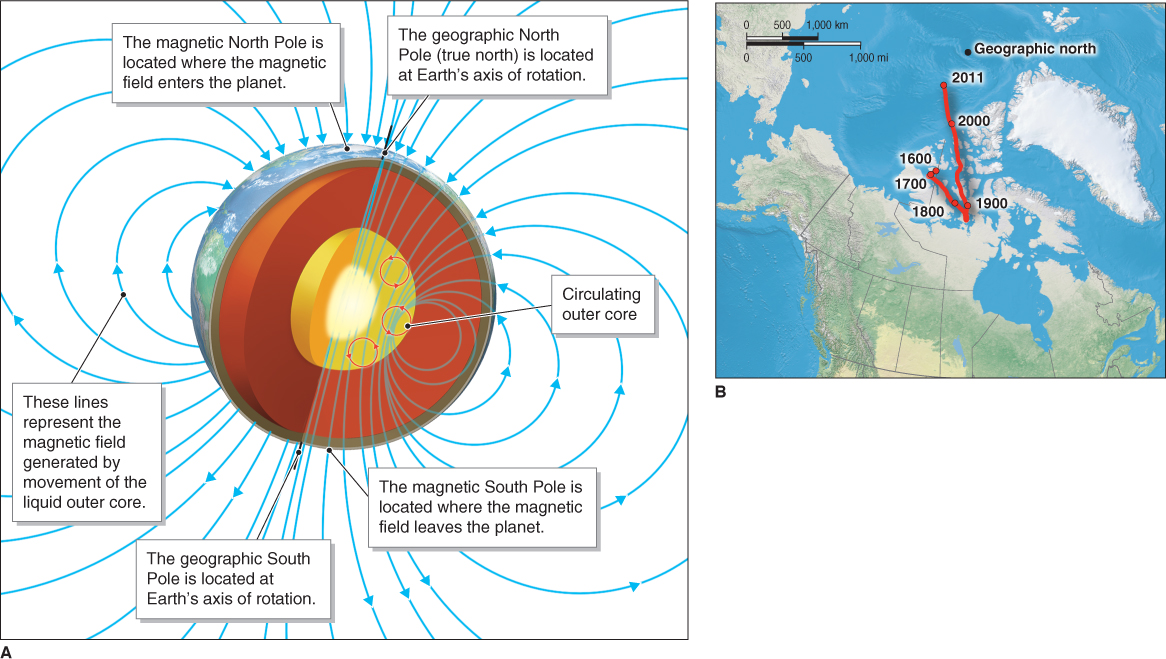
 The magnetic field also forms the magnetosphere, which surrounds Earth and shields it from the solar wind, a stream of electrically charged particles emitted by the Sun (see Figure 11.15). This critical function is explored further in the Geographic Perspectives at the end of this chapter. Because the magnetic field is perpendicular to Earth’s surface near the poles, it allows the solar wind to reach the uppermost atmosphere, causing it to light up, creating auroras, or northern and southern lights (see Section 1.3).
The magnetic field also forms the magnetosphere, which surrounds Earth and shields it from the solar wind, a stream of electrically charged particles emitted by the Sun (see Figure 11.15). This critical function is explored further in the Geographic Perspectives at the end of this chapter. Because the magnetic field is perpendicular to Earth’s surface near the poles, it allows the solar wind to reach the uppermost atmosphere, causing it to light up, creating auroras, or northern and southern lights (see Section 1.3).
The Mantle
The mantle is the layer of heated and slowly deforming solid rock that lies between the base of the crust and the outer core. The lower limit of the mantle lies 2,900 km (1,802 mi) below the surface, and it extends upward to approximately 35 km (22 mi) below the surface. Temperatures in the mantle range from about 4,000°C (7,232°F) near the outer core to about 900°C (1,652°F) near the crust.
mantle
The layer of heated and slowly deforming solid rock between the base of the crust and the outer core.
The mantle has three layers: the lower mantle, the asthenosphere, and the lithospheric mantle (see Figure 11.10). Altogether, the mantle makes up about 84% of Earth’s volume. It is composed of silicate rocks (made mostly of minerals that contain silica) that are rich in iron and magnesium. These rocks are heated to temperatures well above their melting point. Because they are under such great pressure, however, they remain solid.
Even though the lower mantle is solid rock, it is not rigid and unmovable. Instead, it slowly deforms and flows in great circular convection loops at a rate of about 15 cm (6 in) per year. When a solid is able to deform and flow, its behavior is described as plastic. Warm (but unmelted) candle wax or beeswax is plastic in that it can be squeezed and shaped with your fingers once it is warmed.
The asthenosphere (from the Greek for “weak”) is the layer of the mantle found between depths of about 100 and 200 km (62 and 124 mi). There is considerably less pressure in the asthenosphere than in the rest of the mantle below. As a result, although the rocks here are still in a solid state, they are nearer to melting and are consequently weak and easily deformed. In contrast, the outermost portion of the mantle, the lithospheric mantle, is rigid and relatively brittle. The lithospheric mantle is discussed next in the context of the third major layer of Earth’s interior, the lithosphere.
asthenosphere
The layer of the mantle, which deforms and flows, found between about 100 and 200 km (62 and 124 mi) in depth.
The Lithosphere
The lithosphere consists of Earth’s rigid crust and the rigid lithospheric mantle beneath it, extending to a depth of about 100 km (62 mi) on average (see Figure 11.10). The lithosphere is not plastic and does not deform and flow. Instead, when subjected to stresses from the moving asthenosphere beneath, it cracks and breaks, forming lithospheric plates. These plates are important because their movement drives earthquake and volcanic activity, which we will explore in Chapter 12.
lithosphere
The layer of Earth that consists of the rigid crust and the rigid lithospheric mantle beneath it, extending to a depth of about 100 km (62 mi) on average.
The outermost portion of the lithosphere, the crust, is the part of Earth we walk on and that the atmosphere and oceans rest on. The crust is not melted by Earth’s internal heat because it is in contact with the atmosphere and oceans, which are relatively cold. Although Earth’s crust makes up less than 1% of Earth’s volume, it is very important to people. It is home. It is where we grow food, extract minerals and energy resources such as petroleum, and build our houses and cities.
Why doesn’t the hot interior of Earth melt the crust?
The atmosphere and oceans are cold and prevent Earth’s hot interior from melting the crust.
There are two types of crust: continental crust and oceanic crust.Continental crust makes up the continents. It is composed mainly of granite, a silica-
continental crust
The crust that makes up the continents, composed mainly of granite.
granite
A silica-
oceanic crust
The crust beneath the oceans, composed mainly of basalt.
basalt
A dark, heavy, fine-
Granite forms from magma that cools deep in the crust. Magma is melted rock that is below the surface of the crust. Chemically, granite is composed chiefly of silica, aluminum, potassium, calcium, and sodium. It is light in both weight (2.7 g/cm3) and color compared with basalt, which weighs about 3 g/cm3. But not all continental rocks are granite. Rocks found on the continents vary more in age and chemistry than do those in oceanic crust, and they come from different formative processes than the rocks found on the seafloor.
magma
Melted rock that is below the surface of Earth’s crust.
Basalt, on the other hand, is formed from lava. Lava is magma that spills onto the surface of the crust. Chemically, basalt is composed mostly of compounds of silica that are high in iron and magnesium. When melted, basalt has low viscosity, which means that it is runny and flows easily downhill.
lava
Hot molten rock that spills onto the surface of Earth’s crust.
But how thick is the crust? The Croatian scientist Andrija Mohorovicšić (1857–
Moho
The boundary that separates the crust from the lithospheric mantle, which lies about 35 km (22 mi) deep on average.
The Moho is deepest beneath continental crust and shallowest beneath oceanic crust. Beneath oceanic crust, the Moho is found at about 7 km (4 mi) in depth. Beneath continental crust, it is found at about 70 km (40 mi) in depth, but that depth varies with continental topography. It is deepest beneath high mountains and much less deep in areas where the continental crust is being stretched by tectonic processes (Figure 11.12). Overall, the thickness of Earth’s crust is 0.01% to 1% of the radius of the planet, about the same as the thickness of an apple peel as a percentage of the rest of the apple.
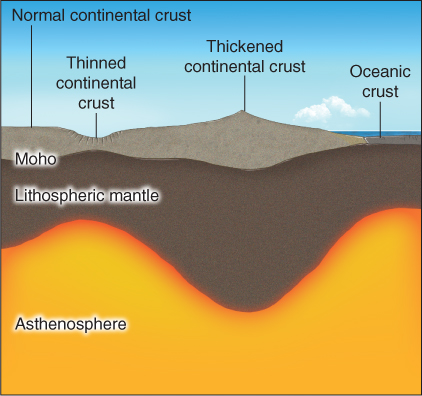
CRUNCH THE NUMBERS: Calculating Travel Time to the Center of Earth
CRUNCH THE NUMBERS: Calculating Travel Time to the Center of Earth
If you drove nonstop toward the center of Earth traveling at 100 km/h (62 mph), how long would it take to get to the upper surface of each of the following layers? For your calculations, divide the distance by travel speed. The first calculation is done for you. (See Figure 11.10 for the depths of each layer.)
The Moho:
Answer:35 km/100 km/h=0.35 hours; 0.35 × 60 minutes=21 minutes.
Question 11.2
2. The asthenosphere:
Question 11.3
3. The outer core:
Question 11.4
4. Earth’s center:
How long would it take to drive to the center of Earth?
It would take 2.7 days to drive to the center of Earth at highway speeds.
As a thought experiment to get a sense of the thicknesses of Earth’s interior layers, Crunch the Numbers asks you to calculate how long it would take to drive to Earth’s center.
Plates of the Lithosphere
The lithosphere is broken into pieces, or plates, each of which moves over Earth’s surface as the mantle beneath it slowly convects. There are 14 major lithospheric plates as well as several minor plates. As Figure 11.13 shows, the margins of these lithospheric plates are sometimes visible on land.
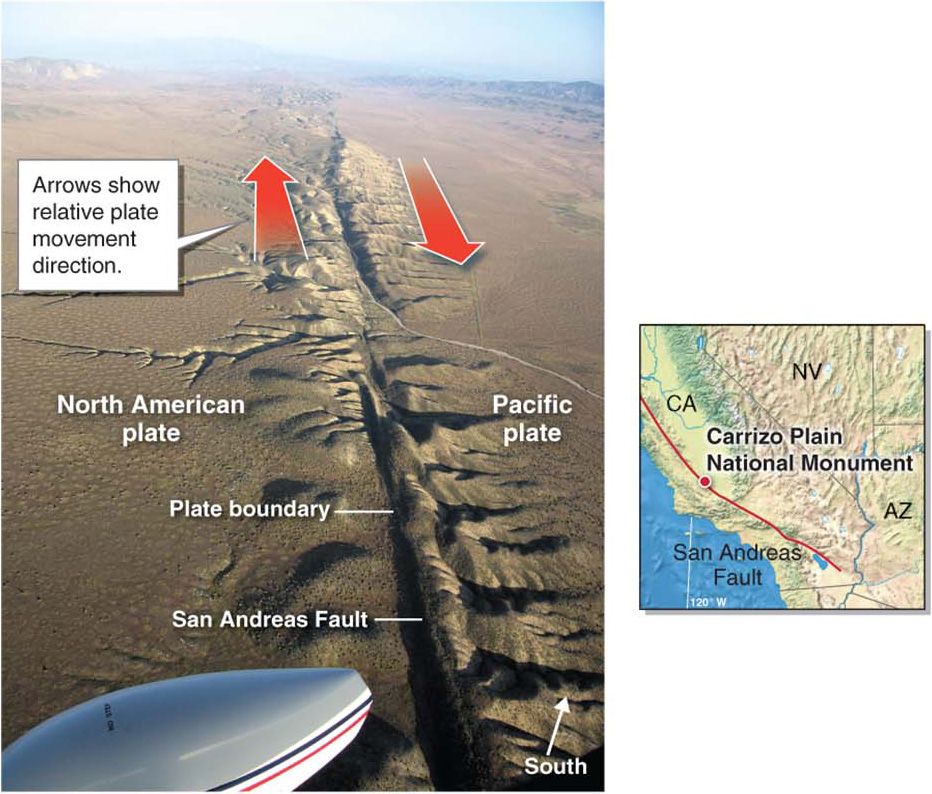
As the plates move, they buckle into mountains, bend and warp into hills, and break, causing earthquakes. If there were no plate tectonics (plate movement), Earth would become flat as weathering and erosion wore the surface down and sediments filled in valleys (a process called gradation). The plates of the lithosphere are also important in the context of heat loss from Earth’s interior to space. Heat loss is not evenly distributed across Earth’s surface, as shown in Picture This.
Picture This
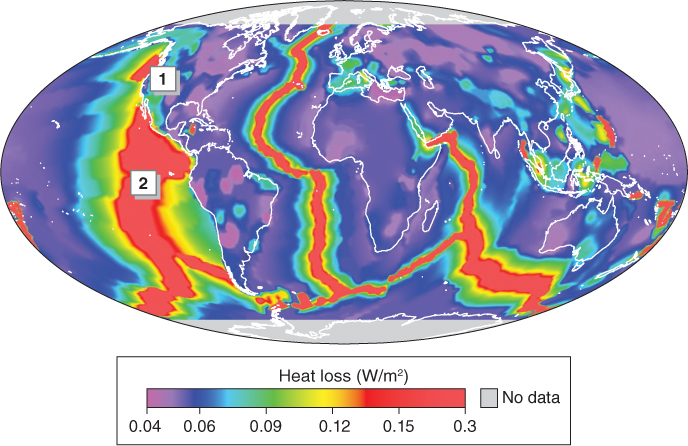
Heat Flow from Earth to Space
This image displays losses of Earth’s internal heat energy through the crust and out to space in watts per square meter. Heat loss is lowest where the crust is thickest, such as at point 1. At many plate boundaries, the crust is thin, and heat loss is high, as at point 2. (Compare this image with the map of lithospheric plate boundaries in Figure 12.7.)
Consider This
Question 11.5
What is the relationship between Earth’s heat loss and lithospheric plate boundaries?
Question 11.6
Observe point 1, in the mountainous west of North America. Relative to the plate boundaries beneath the oceans, is heat loss in this mountainous area high or low?
